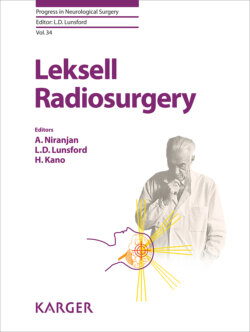Читать книгу Leksell Radiosurgery - Группа авторов - Страница 53
На сайте Литреса книга снята с продажи.
MRI Clinical Protocols
ОглавлениеAt our institution, a high-resolution, gadolinium enhanced 3D localizer (T2* images) image sequence is used first in order to localize the lesion in axial, sagittal, and coronal images. This sequence (3-mm-thick slices, 2 mm apart) only takes about a minute for 11 axial, 11 sagittal, and 11 coronal slices. Using the axial images, the fiducials can be measured and compared to the opposite side to exclude the possibility of MRI artifacts and confirm that there is no angulation or head tilt. Alternatively, T1-weighted sagittal scout images (3-mm-thick slices with 1 mm) using a spin-echo pulse sequence can be obtained for lesion localization. For whole-head stereotactic imaging, we prefer a 3D-volume acquisition using the spoiled-gradient recalled acquisition in steady state (GRASS) sequence at a 256 × 256 matrix and 1 NEX (number of excitations) covering the entire head with 1.5-mm-thick axial slices. The FOV (field of view) is kept at 25 x 25 cm in order to visualize all fiducials. The approximate imaging time for this sequence is 8 min.
We generally prefer 3D spoiled-GRASS (SPGR) and fast spin echo (FSE) T2-weighted sequences for most lesions (Table 1). Additional sequences are performed when more information is needed. Pituitary lesions are particularly difficult to image especially if there has been prior surgery. A half dose of paramagnetic contrast is usually given to image pituitary adenomas. For residual pituitary tumors, after transsphenoid resection, a fat suppression SPGR sequence is recommended, which helps in differentiating tumor from the fat packed in the resection cavity.
Table 1. Stereotactic Imaging for Leksell Radiosurgery
For cavernous malformations, an additional VEMP (variable echo multiplanar) imaging can be obtained to define the hemosiderin rim. For thalamotomy planning, an additional short TI inversion recovery (STIR) sequence is performed to differentiate basal ganglia from white matter tracts. Brain metastases patients receive a double dose of contrast agent and the entire brain is imaged by 1.5- or 2-mm slices to identify all of the lesions. Before removing the patients from the MRI scanner, the images must be checked for accuracy.
